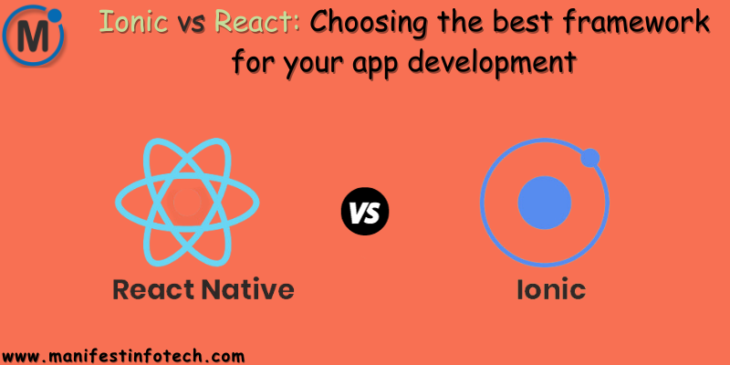
Let’s dive into the key features and considerations to help you make an informed choice.
𝐈𝐨𝐧𝐢𝐜: 𝐓𝐡𝐞 𝐏𝐨𝐰𝐞𝐫 𝐨𝐟 𝐂𝐫𝐨𝐬𝐬-𝐏𝐥𝐚𝐭𝐟𝐨𝐫𝐦 𝐃𝐞𝐯𝐞𝐥𝐨𝐩𝐦𝐞𝐧𝐭:
𝟏. 𝐇𝐲𝐛𝐫𝐢𝐝 𝐀𝐩𝐩 𝐃𝐞𝐯𝐞𝐥𝐨𝐩𝐦𝐞𝐧𝐭: Ionic is renowned for its ability to create cross-platform applications. By leveraging web technologies like HTML, CSS, and JavaScript, Ionic allows developers to build once and deploy across multiple platforms.
𝟐. 𝐑𝐢𝐜𝐡 𝐔𝐈 𝐂𝐨𝐦𝐩𝐨𝐧𝐞𝐧𝐭𝐬: Ionic comes with a plethora of pre-built UI components that are optimized for mobile devices. These components provide a native-like feel, ensuring a smooth user experience.
𝟑. 𝐀𝐜𝐜𝐞𝐬𝐬 𝐭𝐨 𝐍𝐚𝐭𝐢𝐯𝐞 𝐅𝐞𝐚𝐭𝐮𝐫𝐞𝐬: While Ionic primarily uses web technologies, it provides access to native device features through plugins. This allows developers to incorporate functionalities like camera access, GPS, and push notifications seamlessly.
𝐑𝐞𝐚𝐜𝐭: 𝐔𝐧𝐥𝐞𝐚𝐬𝐡𝐢𝐧𝐠 𝐭𝐡𝐞 𝐏𝐨𝐰𝐞𝐫 𝐨𝐟 𝐂𝐨𝐦𝐩𝐨𝐧𝐞𝐧𝐭𝐬:
𝟏. 𝐂𝐨𝐦𝐩𝐨𝐧𝐞𝐧𝐭-𝐁𝐚𝐬𝐞𝐝 𝐀𝐫𝐜𝐡𝐢𝐭𝐞𝐜𝐭𝐮𝐫𝐞: React’s core strength lies in its component-based architecture. Breaking down the UI into reusable components not only enhances code maintainability but also facilitates a modular and scalable development process.
𝟐. 𝐕𝐢𝐫𝐭𝐮𝐚𝐥 𝐃𝐎𝐌 𝐟𝐨𝐫 𝐏𝐞𝐫𝐟𝐨𝐫𝐦𝐚𝐧𝐜𝐞: React introduces a Virtual DOM, a lightweight copy of the actual DOM. This allows React to make efficient updates by only rendering the components that have changed
𝟑. 𝐄𝐱𝐭𝐞𝐧𝐬𝐢𝐯𝐞 𝐄𝐜𝐨𝐬𝐲𝐬𝐭𝐞𝐦: Backed by Facebook, React boasts a robust ecosystem with a wide range of libraries and tools. The community support is unparalleled, providing developers with resources, solutions, and a wealth of third-party integrations.
𝐌𝐚𝐤𝐢𝐧𝐠 𝐭𝐡𝐞 𝐃𝐞𝐜𝐢𝐬𝐢𝐨𝐧: 𝐅𝐚𝐜𝐭𝐨𝐫𝐬 𝐭𝐨 𝐂𝐨𝐧𝐬𝐢𝐝𝐞𝐫
𝟏. 𝐏𝐫𝐨𝐣𝐞𝐜𝐭 𝐑𝐞𝐪𝐮𝐢𝐫𝐞𝐦𝐞𝐧𝐭𝐬: Consider the specific needs of your project. If cross-platform compatibility is a priority and you prefer a single codebase, Ionic might be the better fit. On the other hand, if your project demands a highly interactive and dynamic user interface, React’s component-based architecture might be the way to go.
𝟐. 𝐃𝐞𝐯𝐞𝐥𝐨𝐩𝐦𝐞𝐧𝐭 𝐓𝐞𝐚𝐦 𝐄𝐱𝐩𝐞𝐫𝐭𝐢𝐬𝐞: Evaluate the expertise of your development team. If they are well-versed in web technologies, Ionic might be an easier transition. React, with its JSX syntax and component-based structure, might be more suitable for teams familiar with JavaScript and modern frontend development.
𝟑. 𝐏𝐞𝐫𝐟𝐨𝐫𝐦𝐚𝐧𝐜𝐞 𝐂𝐨𝐧𝐬𝐢𝐝𝐞𝐫𝐚𝐭𝐢𝐨𝐧𝐬: If performance is a critical factor, React’s Virtual DOM can offer significant optimizations. However, Ionic’s performance is no slouch, especially for less resource-intensive applications.
If you are looking for any services related to Website Development, App Development, Digital Marketing and SEO, just email us at nchouksey@manifestinfotech.com or Skype id: live:76bad32bff24d30d
𝐅𝐨𝐥𝐥𝐨𝐰 𝐔𝐬:
𝐋𝐢𝐧𝐤𝐞𝐝𝐢𝐧: linkedin.com/company/manifestinfotech
𝐅𝐚𝐜𝐞𝐛𝐨𝐨𝐤: facebook.com/manifestinfotech/
𝐈𝐧𝐬𝐭𝐚𝐠𝐫𝐚𝐦: instagram.com/manifestinfotech/
𝐓𝐰𝐢𝐭𝐭𝐞𝐫: twitter.com/Manifest_info
#IonicVsReact #AppDevelopment #FrameworkComparison #TechDecisions #CrossPlatformDev #ReactJS #IonicFramework #MobileAppDev #CodeChoices #FrontendDevelopment #TechBlog #DevTalk #WebTech #ReactNative #MobileDevelopment #CodeJourney #ProgrammingChoices #TechInsights #AppFramework #DevCommunity